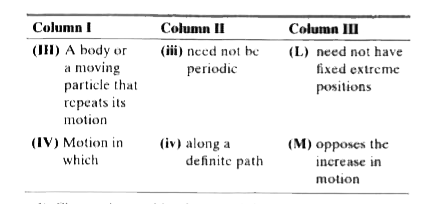Define the term wave motion. Give four important characteristics of wave motion.
Step-by-Step Solution
Step 1: Define Wave Motion
Wave motion refers to the transfer of energy and momentum through a medium without the permanent displacement of the particles of the medium. In wave motion, particles of the medium oscillate around their equilibrium positions, allowing the wave to propagate through the medium. For example, in sound waves, air particles vibrate back and forth, transferring energy without moving from their original positions.
Step 2: Identify the Characteristics of Wave Motion
1. Types of Waves: Waves can be classified based on the direction of particle vibration relative to the direction of wave propagation. The two main types are:
- Longitudinal Waves: In these waves, particles of the medium vibrate parallel to the direction of wave propagation. An example is sound waves, where air particles compress and rarefy in the same direction as the wave travels.
- Transverse Waves: In these waves, particles of the medium vibrate perpendicular to the direction of wave propagation. An example is waves on a string, where the displacement of the string is up and down while the wave travels horizontally.
2. Medium Requirement: Waves can also be classified based on whether they require a medium to propagate:
- Mechanical Waves: These require a medium (solid, liquid, or gas) to travel. Examples include sound waves and water waves.
- Non-Mechanical Waves: These do not require a medium for propagation. Examples include electromagnetic waves, such as light waves and X-rays.
3. Dimensionality of Waves: Waves can be classified based on the dimensionality of energy transfer:
- 1D Waves: These waves propagate in one dimension, such as waves on a string.
- 2D Waves: These waves propagate in two dimensions, like ripples on the surface of water.
- 3D Waves: These waves propagate in three dimensions, such as sound waves spreading out in all directions from a source.
4. Restoration Forces: The motion of waves is influenced by the properties of the medium, specifically elasticity and inertia. Elasticity allows the medium to return to its original position after being disturbed, while inertia causes the medium to resist changes in motion, resulting in oscillatory motion.
Summary of Characteristics
1. Types of Waves: Longitudinal and Transverse.
2. Medium Requirement: Mechanical (requires medium) and Non-Mechanical (does not require medium).
3. Dimensionality: 1D, 2D, and 3D waves.
4. Restoration Forces: Influenced by elasticity and inertia.
---
Wave motion refers to the transfer of energy and momentum through a medium without the permanent displacement of the particles of the medium. In wave motion, particles of the medium oscillate around their equilibrium positions, allowing the wave to propagate through the medium. For example, in sound waves, air particles vibrate back and forth, transferring energy without moving from their original positions.
1. Types of Waves: Waves can be classified based on the direction of particle vibration relative to the direction of wave propagation. The two main types are:
- Longitudinal Waves: In these waves, particles of the medium vibrate parallel to the direction of wave propagation. An example is sound waves, where air particles compress and rarefy in the same direction as the wave travels.
- Transverse Waves: In these waves, particles of the medium vibrate perpendicular to the direction of wave propagation. An example is waves on a string, where the displacement of the string is up and down while the wave travels horizontally.
- Mechanical Waves: These require a medium (solid, liquid, or gas) to travel. Examples include sound waves and water waves.
- Non-Mechanical Waves: These do not require a medium for propagation. Examples include electromagnetic waves, such as light waves and X-rays.
- 1D Waves: These waves propagate in one dimension, such as waves on a string.
- 2D Waves: These waves propagate in two dimensions, like ripples on the surface of water.
- 3D Waves: These waves propagate in three dimensions, such as sound waves spreading out in all directions from a source.
1. Types of Waves: Longitudinal and Transverse.
2. Medium Requirement: Mechanical (requires medium) and Non-Mechanical (does not require medium).
3. Dimensionality: 1D, 2D, and 3D waves.
4. Restoration Forces: Influenced by elasticity and inertia.
Similar Questions
Knowledge Check
- Question 1 - Select One
Wave motion is periodic in
AspaceBspace and timeCtimeDdirection
Discuss some of the important characterisitcs of wave motion.
View SolutionDefine the terms wave and wave motion.
View SolutionWave Motion L1
View SolutionExplain what is meant by wave motion.
View SolutionDefine electromagnetic waves. State the characteristics of e.m.waves.
View SolutionGive some important features of uniform motion.
View SolutionIn the given table, Column I gives type of motion, Column II gives the path traced and Column III gives other characteristic of the motion.


Choose the combination that defines the characteristics of periodic motion.View Solution

